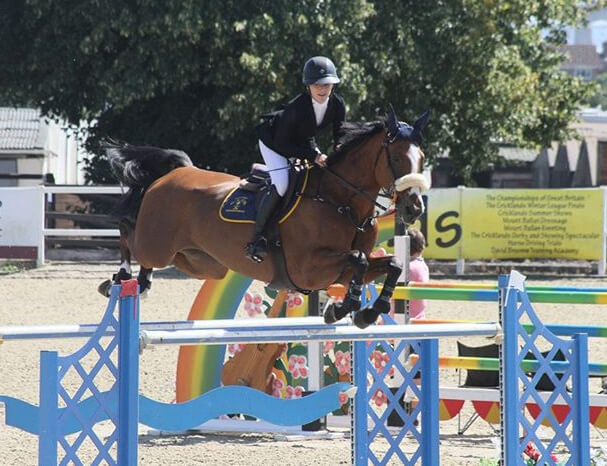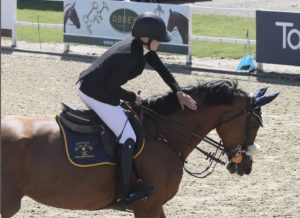Rein contact is probably one of the biggest anomalies within the field of training. Let’s say you’re having a particular issue – maybe your horse is forward-going, and is rushing his fences – you will receive a range of ‘helpful’ advice from other people, all with slightly differing opinions. This is because all horse are different, and we have all experienced different solutions and ways of riding such a horse, depending on the equine in question!
Differences of opinion
Quintella GT Olympia 2019Some trainers and peers with tell you to lengthen the reins, because with a shorter rein, you’re restricting the horse’s neck. A longer rein can stop you from restraining the forward movement, which you may have been doing because you’re trying to control the take off point too much, or even because you’re a little scared of the horse’s power (and whether it may lead to inaccuracies), or even the fence height, and are ‘holding on’. Others will tell you to take a stronger contact as you approach the fence, to give the horse more confidence, ‘hold his hand’ metaphorically, and feel a stronger connection in your hand. A shorter rein can certainly keep the energy more contained, and the horse on its hocks.
Both answers can be correct, but I would say it does depend on so many factors, notably the trustful connection you have with the horse (possibly related to how long you have been ‘together’), the height of the fences, your capabilities as an adaptive and intuitive rider, and of course the horse’s bitting regime and mouth conformation. There are training factors too, for example connected with your position and how well you’re anchored in the saddle; e.g. if you’re well balanced, you then follow the movement of the horse’s with your arms, no matter what position its head is in, and no matter what your rein length. The horse’s balance and stage of training are also key, e.g. so he’s in self carriage and can take the weight behind. With a young or green horse however, a longer rein is advisable.
 Developing feel
Developing feel
What I would say is that it is important to develop intuition and feel. You can ride with a long rein and have a strong contact, or ride with a short rein and utilise a soft contact. Working with your trainer at different rein lengths can help achieve this, to see how your balance and the horse’s way of going are affected by rein length, and vice versa. If you can develop an adaptable rein contact and can train yourself to become adept at rein lengthening and shortening, you may be more able to adapt to the circumstances on the day, if it suits the horse – perhaps taking a sharp turn or pushing on to cover ground, or collecting for a downhill approach. Again, this is trainable and you will develop deft ways to adapt your reins without others even noticing. This does depend on the horse in question of course, e.g. for a more sensitive-mouthed horse, I would try to keep a consistent and quiet contact, and adapt my body rather than my rein length.
Establishing rein length
Georgia Quintella Chepstow 2019If I were to pick between a longer or shorter rein, I would actually go for mid-length to short, as otherwise a forward-going horse off a long stride will tend to lose accuracy. If this works for your horse, be mindful of not tensing up at the shoulders and ‘bracing’ through the body and hands, which makes things worse, and can lead to the aforementioned restraint of forward movement (often resulting in a final ‘unleashing’ of the energy over the fence, which then needs containing again, upon landing!). Remember that it’s his job to jump; we can interfere too much.
Remember too that your rein should create a feeling of support for the horse – a sensitive, consistent rein contact (coupled with your seat and leg aids) instils trust within the horse.
You may find that a horse rushing a fence can feel your concern about the height of the fence, and knows your driving aids may not be relied upon to clear the jump! They can take matters into their own hands. If you’re sure you’re not over-facing yourself height-wise, try to ‘fake it till you make it’ and work on containing your own nerves, and developing that trustful relationship.
 A question of bitting
A question of bitting
In terms of bitting, bear in mind that a very forward-going horse can be evading – but if this is the case, he must have something to resist against. In a too-harsh bit, the horse may tense up to brace against the pain (or perceived pain) from the bit’s action, and you usually end up pulling against each other. (You will never win!). A horse in an unsuitable bit, e.g. in a mouthpiece that doesn’t allow for tongue space if he has a larger or just more sensitive tongue, will also evade away from the pressure exerted by your hands.
My ride Quintella is a very fast mare, and we’re known for our speed rounds, winning some lovely classes last year including the NAEC Stoneleigh Stakes at the Horse of the Year Show (where I was also awarded leading rider at the show), and also the first round of the prestigious Olympia under 25 Championship.
But she is a strong horse, and when we first joined forces, we had a lot of work to do to find out each others’ buttons, and how I could rider her positively without feeling I was being towed around a course!
Georgia Quintella in hybridAs she’s pretty sensitive-mouthed and her mouth is quite fleshy, I ride her in a Bombers Hybrid, which is a combination of a mechanical hackamore and an American gag. It’s certainly not for everyone, but in the right hands, it can be ideal for strong horses, as it distributes pressure uniformly on the nose, mouth and the poll.
With the double reins I find the bit gives me great rein independence, e.g. I can really utilise each hand to influence direction. Quintella can carry her head very high, not just on the approaches but also throughout the course, but I try to keep a very consistent contact with fairly raised hands, and this means that the movement of her head doesn’t affect our balance or accuracy too much.
Georgia Tame jumps under the auspices of Breen Equestrian and rides internationally at all levels, including five star.
She was a member of the silver medal winning British team at the European Jumping Championships in France with Z7 Cash Up.
#bombersbits #bombersbluebits #teambombers #bombersbitsbringbalance #bombersbits #BombersEquestrianEquipment #BombersBlueBits




 Developing feel
Developing feel A question of bitting
A question of bitting